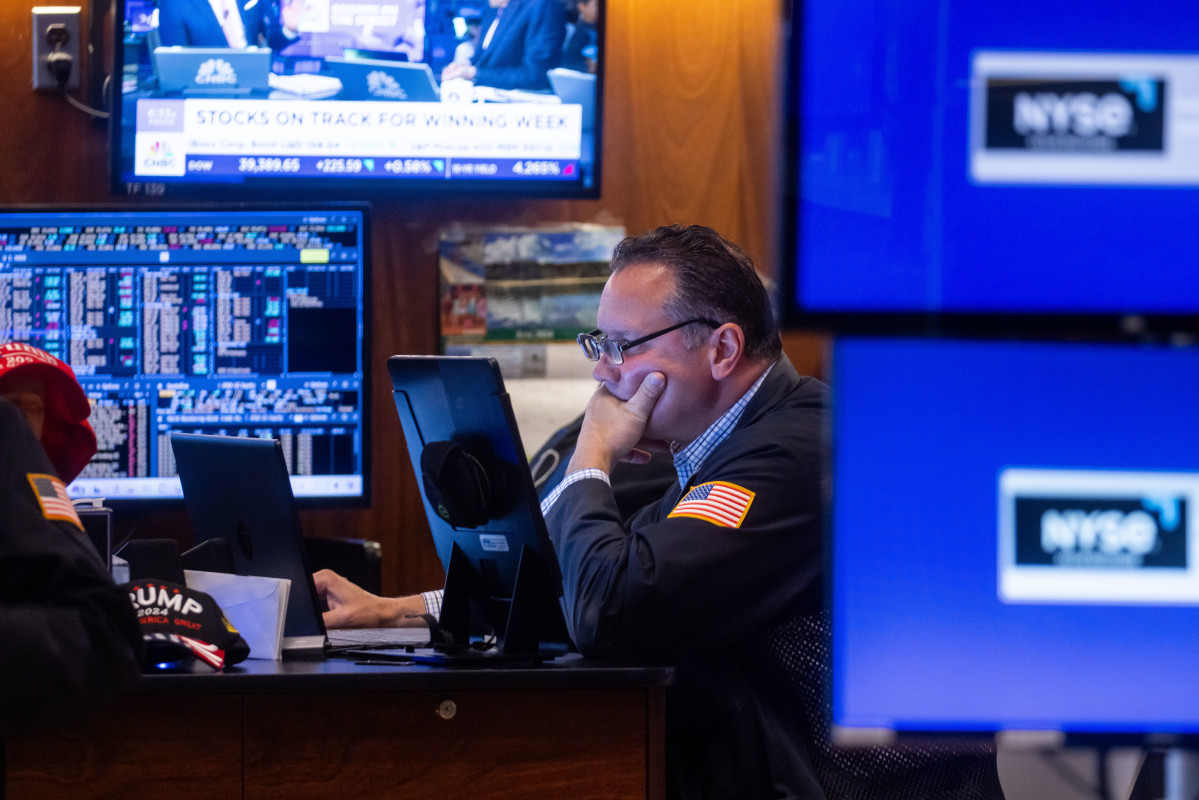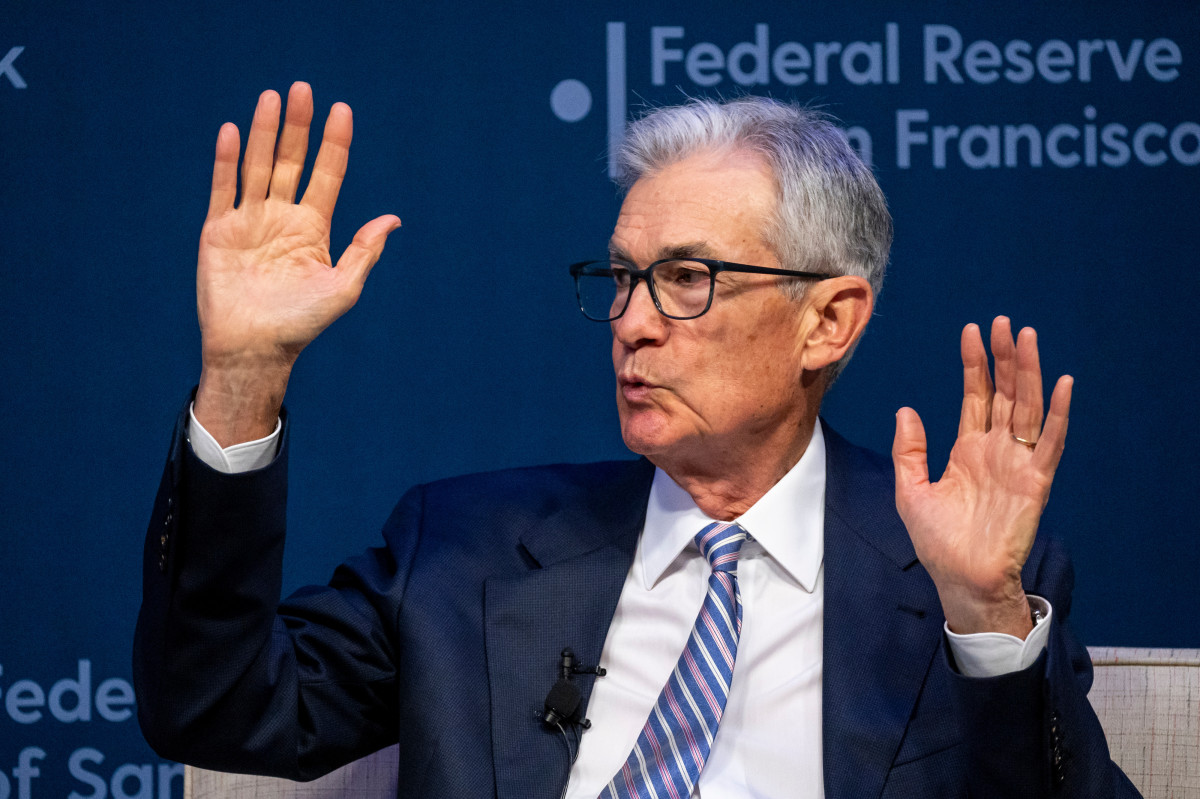
Investors could face an additional headwind to September's traditional weakness. Stocks delivered their worst weekly performance in over a year, amid one of the most significant moves in the bond market since the Covid pandemic.
U.S. stocks, which peaked in mid-July before falling hard in early August, attempted to regain their all-time highs last month. But they failed to find momentum from either Federal Reserve Chairman Jerome Powell's Jackson Hole speech or Nvidia's (NVDA) solid but unspectacular fiscal second-quarter earnings.
The up-and-down pattern over the past two months has led to concern about a so-called double top in the S&P 500. A double top occurs when the index reaches two recent highs with a moderate decline in between before extending a longer-term retreat.
The double-top pattern, meanwhile, comes just before the first reversion of the U.S. Treasury yield curve in more than two years, a move that many analysts see as a precursor to recession in the world's biggest economy.
Benchmark 2-year Treasury note yields fell below their 10-year counterparts last week and have remained lower heading into the Monday trading session, following the longest inversion on record, which began in July 2022.
An inverted yield curve normally indicates recession risks, but the recession it predicts doesn't occur until the yield curve normalizes, with short-term yields falling below longer-term yields.

Is a bond-market bull steepening in the offing?
Treasury bond yields, which move in the opposite direction to prices, can reflect both bets on near-term Fed interest rates and speculation on the health of the broader economy.
Related: Stocks search for lost mojo after drubbing
Lower benchmark 2-year Treasury note yields now suggest Federal Reserve interest-rate cuts, which are expected to begin on September 18 in Washington and continue into the start of next year.
They're falling faster, however, than longer-term yields, which are influenced by investors looking to park money in a risk-free asset in the face of a weakening economy.
This so-called bull steepening is typically associated with Fed easing cycles but has also evolved prior to recession in the early 1990s, the early 2000s, and just after the global financial crisis in 2008.
Benchmark 2-year notes were last seen trading at 3.708%, compared with 3.761% for 10-year notes.
"Short-term yields dropped significantly in all recessions, while long-term yields varied, influenced by the Fed's actions and market expectations of future growth and inflation," said Althea Spinozzi, head of fixed-income strategy at Saxo Bank.
"In all three scenarios, bonds have gained while stocks were crashing," she added, noting that the S&P 500 fell 35.7% during the Great Recession of 2007 to 2009, with most of the slump coming amid the Fed's aggressive rate cuts.
Economy is slowing, but no recession yet
The economy, while slowing, remains a long way from recession. But Friday's weaker-than-expected August jobs report, which included downward revisions for June and July, suggests a tough road ahead into the end of the year and beyond.
Related: Jobs report surprise adds to case for bigger Fed interest rate cuts
Crude oil prices, which typically reflect global demand tied to economic growth prospects, are trading at their lowest levels in more than a year. WTI futures for October delivery are pegged firmly below the $70 per barrel mark.
Rick Rieder, BlackRock’s chief investment officer of global fixed income, isn't buying the recession gloom, however, and argues that the U.S. economy is "moderating" and not "falling off a cliff."
"While the jobs data is clearly softer than what we, and the Fed, have been used to witnessing, it is very far from a disastrous indicator of recession, hard landing, or some pernicious foreshadowing of future consumer weakness," he said.
The bond market's recent record in predicting recession isn't stellar either, with the world's biggest economy defying its gloomy forecast for all of 2022, 2023, and the first half of this year.
Earnings growth remains solid
The Atlanta Fed's GDPNow forecasting tool suggests a current-quarter growth rate of 2.1%, down from the 3% pace recorded over the three months ended in June but still a long way from contraction and recession.
S&P 500 earnings estimates are also holding up, with third-quarter profits expected to rise 5.7% from last year to $513 billion.
Sign up for TheStreet's free daily newsletter.
For the whole of 2024, profits are forecast to rise 10.2%, more than double the 2023 tally, before rising by another 15.4% in 2025, according to LSEG data.
Still, the benchmark S&P 500 has fallen more than 4.2% this month, dragging it into negative territory for the quarter. And at a price-to-earnings multiple of around 21.2 times, it remains expensive in historical terms, heading into a likely economic slowdown.
Related: Fed rate cuts may not guarantee a September stock market rally
Investors now look to this week's August inflation reports, next week's Fed rate decision, and the start of the third quarter earnings season in early October to gauge the market's prospects heading into the year's final months.
A hotter-than-expected inflation reading could solidify bets that the Fed will take its rate cut cycle slowly and add to concern that the economy is starting to bend under the stress of high borrowing costs.
More Economic Analysis:
- Kamala Harris sees markets stars align against Donald Trump
- CPI report upsets betting on big Fed rate cut
- Main Street businesses push back on Wall Street recession gloom
A muted start to the third-quarter reporting season, which comes just weeks before the November elections, could add another layer of caution to an already jittery market.
"After more than two years of obsessing about inflation, the markets have turned a corner," said Chris Larkin, managing director for trading and investing at E-Trade from Morgan Stanley.
"The first week of September followed the bearish seasonal playbook, as soft economic data fueled debate about the possibility of a recession and whether the Fed will cut by 0.25% or 0.5% later this month," he added.
"But for stock traders and investors, the more immediate concern is volatility. Last week was the biggest down week for the S&P 500 since March 2023, and if history is any guide, the ride could continue to be bumpy," Larkin said.
Related: Veteran fund manager sees world of pain coming for stocks







